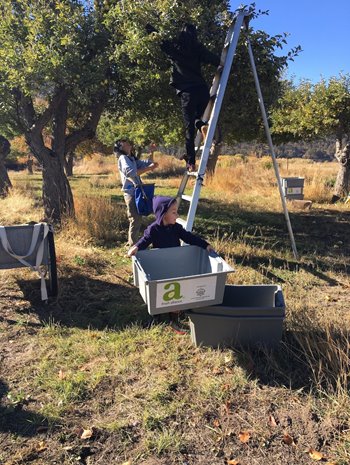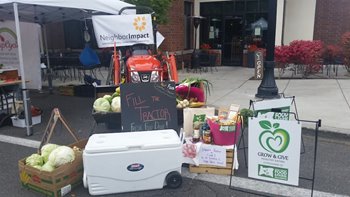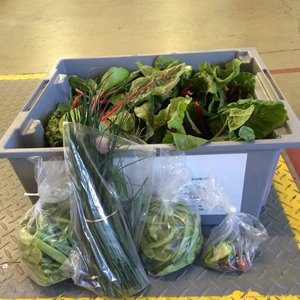It's the leafy greens and peaches that residents go for the most this time of year, shares Carly Sanders, food program director for NeighborImpact. She's talking about the fresh produce that comes from a partnership between the NeighborWorks network organization and High Desert Food and Farm Alliance (HDFFA). The HDFFA matches farmers who have extra produce with NeighborImpact's food bank.
 The five-year partnership started with a gleaning program, Sanders says. But now, NeighborImpact benefits from a full Give & Grow campaign. “They go out to farms and bring the extra bounty back to our food bank," Sanders says. “They also go to local farmers' markets at the end of the day."
The five-year partnership started with a gleaning program, Sanders says. But now, NeighborImpact benefits from a full Give & Grow campaign. “They go out to farms and bring the extra bounty back to our food bank," Sanders says. “They also go to local farmers' markets at the end of the day."
By the end of August, that meant 15,000 pounds in extra produce for the food bank. “That's half a semi load,"says Sanders. They expect 25,000 pounds by the end of the growing season in October. “Clients love it because they get things we aren't typically able to source at the food bank: Lots of leafy greens, beets and squash. The tomatoes are coming in, and kohlrabi and carrots. We also get donations from a local orchard." NeighborImpact's food bank serves about 1,200 residents each month, but saw a spike during the pandemic.
“During COVID-19, food accessibility was one of the critical services NeighborWorks network organizations provided to their communities," says Romi Hall, director of Healthy Homes and Communities for NeighborWorks America. “Partnerships like the one between NeighborImpact and HDFFA are important to respond in short-term crisis and also in the long term as residents' food accessibility needs continue. Having access to fresh, nutritious foods is foundational to an individual, as well as to a community's health." The work of the organizations also ensures no produce is wasted.
important to respond in short-term crisis and also in the long term as residents' food accessibility needs continue. Having access to fresh, nutritious foods is foundational to an individual, as well as to a community's health." The work of the organizations also ensures no produce is wasted.
Chantel Welch, program director for HDFFA, says her organization has been able to grow over recent years because of their direct relationship with farmers. Some farmers donate extra produce that they're unable to sell, knowing that Welch's team can get it quickly to those who need it. Some farmers plant crops specifically to share with food banks. “It's part of their mission as farmers to increase food access."
years because of their direct relationship with farmers. Some farmers donate extra produce that they're unable to sell, knowing that Welch's team can get it quickly to those who need it. Some farmers plant crops specifically to share with food banks. “It's part of their mission as farmers to increase food access."
HDFFA has four programs, including Give & Grow, agricultural support, a Food & Farm Directory, and a produce prescription program. They encourage both locally sourced produce for restaurants and fancy dinners. In addition, “we want someone who visits a food pantry to have that same access to locally grown, fresh food," Welch says.
Now that HDFFA is in a routine with their farmers, the organization is working to reach out to gardeners. The goal is to grow the program each year.
“The mobile pantry has been a huge help to my family this past year,"said one resident. “We are so grateful for the free food -- especially all of the fresh fruit and vegetables."
Welch's and Sanders' advice for NeighborWorks network organizations that might consider adding fresh, locally sourced produce to their food banks includes:
- Have a plan. Plan which agencies and clients can accept fresh produce and get it to clients quickly.
- Prepare. For gleaning programs, prepare with supplies and strategies before volunteers arrive at a farm so you can maximize your time in the fields and orchards.
- Inform. Let the community know what you're looking for locally to round out the variety of produce that you may not be getting through normal donation channels.
- Start small. One of the programs HDFFA has this year includes a Fresh Harvest Kit, similar to popular mail-order food kids. The program pairs a recipe with food pantry staples and fresh produce. Welch says a project like this might be a good place to begin.
- Find a partner who understands farmers. Understanding farmers and the farming cycle makes communication easier. It's important to know what food has the highest demand and how to distribute items quickly, before they spoil. The food bank shouldn't have to do everything itself. “Find an expert in the farm and ranch world and build the relationship," Welch suggests.
- Ask the clients. Ask pantry clients what is most desirable during the harvest season so you can tailor your gleaning events to those produce types.

